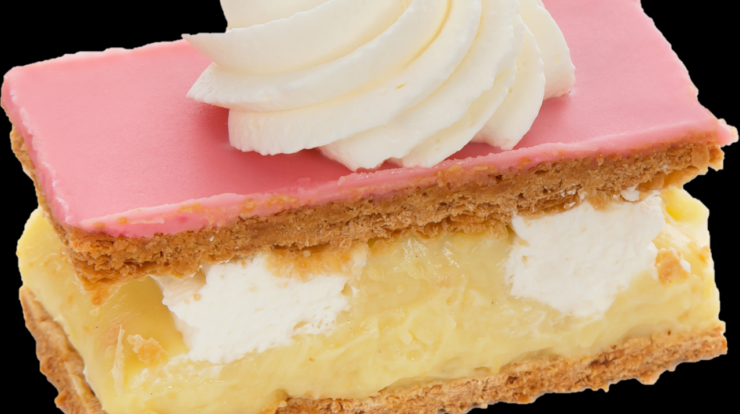
Tompouce, a delectable pastry with a rich history and diverse variations, has captured the hearts and taste buds of people worldwide. Originating in the Netherlands, this treat has evolved into a beloved dessert enjoyed in various forms across different regions.
Composed of layers of flaky pastry, creamy filling, and a glossy glaze, tompouce tantalizes the senses with its exquisite taste and texture. From classic flavors to innovative interpretations, this pastry continues to delight and inspire culinary enthusiasts.
History of Tompouce

Tompouce, a delectable pastry, traces its roots back to the Netherlands in the 19th century. It is believed to have originated from the French mille-feuille, a layered pastry with cream filling. Dutch bakers adapted the mille-feuille, creating a pastry with a puff pastry base, vanilla custard filling, and a pink glaze.
Tompouce quickly gained popularity in the Netherlands and spread to other parts of Europe, becoming a beloved treat.
Cultural Significance and Popularity
Tompouce holds a special place in Dutch culture, often associated with celebrations and festivities. It is a popular treat during King’s Day, the national holiday of the Netherlands, and is also enjoyed as a snack or dessert. Tompouce has gained popularity in other countries as well, with variations found in Belgium, France, and even Japan.
Ingredients and Variations
Tompouce typically consists of a puff pastry base, vanilla custard filling, and a pink glaze. The puff pastry is made from flour, butter, water, and salt, and is rolled and folded several times to create its characteristic flaky layers. The vanilla custard filling is made from milk, sugar, eggs, and vanilla extract, and is cooked until thick and creamy.
The pink glaze is made from sugar, water, and food coloring, and is poured over the pastry after it has cooled.
Variations, Tompouce
Variations of tompouce can be found around the world, with different ingredients and flavors. In Belgium, the pastry is known as “tompouce” and is often filled with chocolate custard instead of vanilla. In France, the pastry is called “mille-feuille” and can be filled with a variety of flavors, including chocolate, coffee, and fruit.
In Japan, the pastry is known as “mille-feuille” and is often filled with matcha green tea custard.
Preparation and Techniques
Making tompouce requires precision and attention to detail. The puff pastry must be rolled and folded correctly to create the flaky layers, and the custard filling must be cooked until thick and creamy without curdling. The glaze must be poured over the pastry at the right temperature to create a smooth and even finish.
Tips and Tricks
* Use high-quality ingredients for the best results.
- Roll and fold the puff pastry carefully to create even layers.
- Cook the custard filling over medium heat, stirring constantly to prevent curdling.
- Pour the glaze over the pastry at a temperature of around 100 degrees Fahrenheit.
- Allow the tompouce to cool completely before slicing and serving.
Final Summary
In conclusion, tompouce stands as a testament to the boundless creativity and artistry within the culinary world. Its versatility and enduring appeal have made it a cherished delicacy, enjoyed by generations and sure to continue captivating taste buds for years to come.
FAQ
What is the origin of tompouce?
Tompouce originated in the Netherlands in the 19th century.
What are the typical ingredients used in tompouce?
Tompouce typically consists of puff pastry, custard or whipped cream filling, and a pink fondant glaze.
Are there any variations of tompouce?
Yes, there are various regional variations of tompouce, including those with different fillings, glazes, and shapes.
What is the nutritional value of tompouce?
Tompouce is a calorie-dense pastry with a high content of carbohydrates and fat.
How is tompouce typically served?
Tompouce is often served as a dessert or snack, accompanied by tea or coffee.





